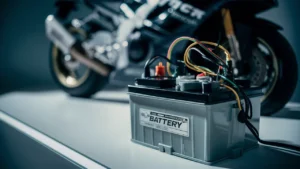Electric scooters are eco-friendly and cost-effective, while petrol scooters offer longer range and faster refueling. Choosing between them depends on your commuting needs and environmental concerns.
The debate between electric scooters and petrol scooters has gained momentum as urban commuting evolves. Electric scooters are celebrated for their low operating costs and minimal environmental impact. They require less maintenance and produce no emissions, making them a popular choice for eco-conscious riders.
On the other hand, petrol scooters boast longer ranges and quicker refueling times, appealing to those who prioritize convenience. Understanding the benefits and drawbacks of each option can help you make an informed decision. As cities become more congested, the choice between electric and petrol scooters is more relevant than ever for daily commuters.
Electric Scooter Vs Petrol Scooter: The Eco-friendly Showdown
The battle between electric scooters and petrol scooters is heating up. Both options offer unique benefits. Understanding their differences helps riders make informed choices. Let’s dive into this exciting showdown.
The Rise Of Electric Mobility
Electric scooters are gaining popularity worldwide. Many riders prefer their eco-friendly features. Here are some reasons for their rise:
- Zero Emissions: Electric scooters produce no harmful gases.
- Lower Operating Costs: Charging is cheaper than buying petrol.
- Quiet Operation: They run silently, reducing noise pollution.
- Government Incentives: Many regions offer tax breaks and subsidies.
Electric scooters appeal to environmentally conscious riders. They support green initiatives and sustainability. The future looks bright for electric mobility.
Traditional Scooters: A Staple Of Urban Transport
Petr0l scooters have been a favorite for years. They are reliable and widely available. Many people trust them for daily commuting. Here are some key points:
| Feature | Electric Scooter | Petr0l Scooter |
|---|---|---|
| Emissions | Zero | High |
| Fuel Costs | Low | High |
| Noise Level | Low | High |
| Maintenance | Less Frequent | More Frequent |
Petrol scooters offer longer ranges. They can travel farther on a single tank. Many riders still prefer them for long trips. Choosing between the two depends on lifestyle and needs.
Assessing Environmental Impact
Electric scooters and petrol scooters have different effects on the environment. Understanding their impact helps make better choices. Let’s explore the carbon footprint and local pollution.
Carbon Footprint Comparison
The carbon footprint measures the total greenhouse gas emissions. Electric scooters generally produce lower emissions than petrol scooters.
| Type of Scooter | Average CO2 Emissions (g/km) |
|---|---|
| Electric Scooter | 0 g/km |
| Petrol Scooter | 60-90 g/km |
Electric scooters run on batteries. They do not emit harmful gases during use. Petrol scooters burn fuel. They release carbon dioxide and other pollutants.
Local Pollution And Air Quality
Local air quality affects health and the environment. Petrol scooters contribute to air pollution. They emit harmful substances like nitrogen oxides and particulate matter.
- Petrol Scooter Emissions:
- Nitrogen Oxides (NOx)
- Carbon Monoxide (CO)
- Particulate Matter (PM)
- Electric Scooters:
- Zero tailpipe emissions
- Less noise pollution
Better air quality leads to healthier communities. Choosing electric scooters can help reduce local pollution. Cleaner air benefits everyone.
Performance Metrics
Performance metrics are crucial for comparing electric scooters and petrol scooters. These metrics include speed, acceleration, range, and fuel efficiency. Understanding these factors helps users choose the right scooter.
Acceleration And Top Speed
Acceleration and top speed are vital for any scooter. Here’s a quick comparison:
| Type | Acceleration (0-60 km/h) | Top Speed |
|---|---|---|
| Electric Scooter | 3-6 seconds | 25-70 km/h |
| Petrol Scooter | 4-8 seconds | 50-100 km/h |
Electric scooters offer quick acceleration. They are perfect for city rides. Petrol scooters have higher top speeds, making them suitable for longer trips.
Range And Fuel Efficiency
Range and fuel efficiency determine how far scooters can go. Here’s how they compare:
- Electric Scooters:
- Range: 40-100 km per charge
- Charging time: 4-8 hours
- Cost per charge: $0.30 – $0.50
- Petrol Scooters:
- Range: 100-300 km per tank
- Refueling time: 5-10 minutes
- Cost per liter: $1.00 – $1.50
Electric scooters are great for short distances. They cost less to run. Petrol scooters excel in range but require more frequent refueling.
Economic Considerations
Choosing between an electric scooter and a petrol scooter involves various economic factors. Understanding these elements helps in making an informed decision. Let’s explore the initial costs and long-term savings of both options.
Initial Costs And Incentives
Initial costs can heavily influence your decision. Here’s a breakdown:
| Type | Average Cost | Incentives |
|---|---|---|
| Electric Scooter | $500 – $2,000 | Tax credits, rebates |
| Petrol Scooter | $300 – $1,500 | None |
Electric scooters often come with government incentives. These can reduce the overall price. Petrol scooters typically do not offer such benefits. They may seem cheaper upfront.
Long-term Savings
Long-term savings play a crucial role in your choice. Here’s how they compare:
- Electric Scooters:
- Lower charging costs
- Less maintenance needed
- Potentially free charging at stations
- Petrol Scooters:
- Higher fuel costs
- Frequent maintenance required
- Environmental fees in some areas
Electric scooters generally offer better long-term savings. Lower operational costs make them more economical over time. Petrol scooters might save money initially but can cost more later.
Maintenance And Durability
Choosing between an electric scooter and a petrol scooter involves understanding their maintenance and durability. Each type has unique needs and longevity factors. This section breaks down key aspects of maintenance, helping you make an informed decision.
Service Intervals And Costs
Service intervals differ significantly between electric and petrol scooters. Regular maintenance ensures longer life and better performance.
- Electric Scooters:
- Brakes need inspection every 6 months.
- Batteries require replacement every 2-4 years.
- Petrol Scooters:
- Oil changes every 1,000-3,000 km.
- Regular filter changes are needed.
- Engine checks every 6 months.
The table below summarizes average service costs:
| Type | Service Cost |
|---|---|
| Electric Scooter | $50 – $100 annually |
| Petrol Scooter | $150 – $300 annually |
Lifespan Of Components
The lifespan of components varies between electric and petrol scooters. Understanding this helps in planning for replacements.
- Electric Scooter Components:
- Batteries: 2-4 years.
- Electric motors: 5-10 years.
- Brakes: 3-5 years.
- Petrol Scooter Components:
- Engines: 5-15 years.
- Fuel tanks: 10-20 years.
- Tires: 3-5 years.
Both scooters have their strengths. Electric scooters need less maintenance, while petrol scooters may last longer overall. Your choice should reflect your usage and preferences.
Charging Vs Refueling
Choosing between an electric scooter and a petrol scooter involves understanding the differences in charging and refueling. Each option offers unique benefits. Knowing these can help you make an informed choice.
Infrastructure Requirements
Electric scooters rely on charging stations. These stations can be found in various locations. Here are some key points:
- Home charging: Install a charger at your home.
- Public charging: Many cities now have charging stations.
- Charging speed varies: Some stations charge quickly, while others take longer.
Pertaining to petrol scooters:
- Fuel stations are widely available.
- Refueling can be done in just a few minutes.
- Infrastructure for petrol is well-established.
Consider the availability of charging stations in your area. This will impact your daily use.
Time And Convenience Factors
Time spent on charging versus refueling is crucial.
| Type | Time Required | Convenience |
|---|---|---|
| Electric Scooter | 4-8 hours (home charging) | Can charge overnight |
| Petrol Scooter | 5-10 minutes | Available at many gas stations |
Charging an electric scooter takes longer than refueling a petrol scooter. However, charging can be done at home while you sleep. This may save time during busy days.
Petrol scooters offer quick refueling. You can fill up and go in minutes. This can be more convenient for some riders.
Think about your daily routine. Choose the option that fits your lifestyle best.
Riding Experience
The riding experience of electric scooters and petrol scooters varies significantly. Each type offers unique advantages and challenges. Understanding these differences can help riders make informed choices. Let’s explore key aspects: noise and vibration, handling, and stability.
Noise And Vibration
Noise levels and vibrations affect the overall comfort of riding. Electric scooters operate quietly, creating a peaceful ride. Riders can enjoy the sounds of nature or music without disturbance.
In contrast, petrol scooters generate noise from the engine. This can be distracting, especially in quiet areas. Additionally, vibrations from the engine can lead to fatigue on longer rides.
Here’s a quick comparison:
| Feature | Electric Scooter | Petrol Scooter |
|---|---|---|
| Noise Level | Very low | High |
| Vibration | Minimal | Moderate to high |
Handling And Stability
Handling and stability are crucial for a safe ride. Electric scooters often have a low center of gravity. This enhances stability, especially at lower speeds. Riders can make sharp turns more easily.
Petrol scooters can feel heavier due to their engine weight. This can affect maneuverability, especially in tight spaces. However, they often perform well at higher speeds.
Here’s a summary of handling characteristics:
- Electric Scooter:
- Lightweight and agile
- Stable at low speeds
- Easy to turn
- Petrol Scooter:
- Heavier design
- Stable at high speeds
- More challenging in tight spots

Future Outlook
The future of scooters is bright and exciting. Electric scooters are rapidly gaining popularity. They offer numerous benefits over petrol scooters, especially in urban areas. Below, we explore key areas shaping this future.
Technological Advancements
Technology is evolving quickly in the scooter market. Key advancements include:
- Battery Technology: Newer batteries provide longer ranges.
- Charging Infrastructure: More charging stations are being built.
- Smart Features: GPS and connectivity enhance the riding experience.
Electric scooters are becoming more efficient and user-friendly. They are also more affordable due to mass production. This trend will likely continue.
Regulatory And Market Trends
Governments are encouraging electric vehicle use. Regulations are changing to support this shift. Here are some key trends:
| Trend | Description |
|---|---|
| Subsidies | Many governments offer financial help for electric scooters. |
| Emissions Regulations | Stricter rules are being placed on petrol vehicles. |
| Public Awareness | People are learning about the benefits of electric scooters. |
Market demand for electric scooters is rising. Many new models are entering the market. This growth will likely lead to more competition.
Frequently Asked Questions
Electric Scooter Vs Petrol Scooter: Which Is Cheaper?
Electric scooters typically have lower operating costs than petrol scooters. Charging an electric scooter is often less expensive than buying petrol. Additionally, electric scooters require less maintenance, saving you money in the long run. Overall, electric scooters are generally more cost-effective for daily commuting.
How Long Does An Electric Scooter Battery Last?
Most electric scooter batteries last between 2 to 5 years, depending on usage and maintenance. Regular charging and proper care can extend battery life significantly. Over time, the battery may lose capacity, affecting range. It’s essential to follow manufacturer guidelines for optimal performance.
Are Electric Scooters More Environmentally Friendly?
Yes, electric scooters produce zero emissions during operation. They help reduce air pollution compared to petrol scooters. Additionally, electric scooters utilize renewable energy sources when charged from eco-friendly grids. This makes them a sustainable choice for urban commuting.
What Is The Range Of An Electric Scooter?
The range of an electric scooter varies by model, typically between 20 to 60 miles on a single charge. Factors such as rider weight, terrain, and speed can affect this range. Choosing the right model for your commuting needs is crucial for optimal performance.
Conclusion
Choosing between an electric scooter and a petrol scooter depends on your lifestyle and values. Electric scooters offer eco-friendliness and lower operating costs. On the other hand, petrol scooters provide longer range and quicker refueling. Assess your needs carefully to make the best decision for your daily commute and environmental impact.








